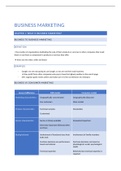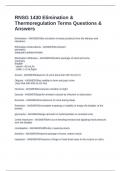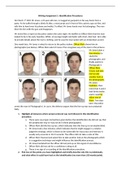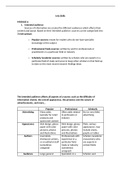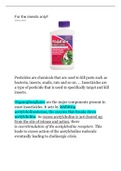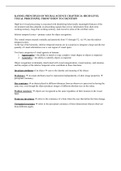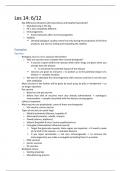Molecular Cell Biology and Immunology
Lecture 7. Immune response to glycolipids and polysaccharides
INDEX
1. T-dependant and T-independent antigens .................................................................................................................................................. 1
2. Recognition of glycopeptides. Glycoconjugate vaccines .............................................................................................................................. 1
2.1. Carbohydrate antigens with protein carrier ........................................................................................................................................ 1
2.2. couple carbohydrate to protein carrier ............................................................................................................................................... 2
2.3. How to study Tcarbs ........................................................................................................................................................................... 2
2.4. Are Tcarb relevant in disease? How prominent are they? ................................................................................................................... 2
2.4.1. Glycosylation ........................................................................................................................................................................................ 2
3. Recognition of glycopeptides ...................................................................................................................................................................... 3
3.1. Identification of glycopeptides in MHC-II ............................................................................................................................................ 3
3.2. Recognition of the glycan modifications ............................................................................................................................................. 3
3.2.1. In a healthy individual are they present? ............................................................................................................................................. 3
3.2.2. Glycan antigen in cancer ...................................................................................................................................................................... 4
4. MHC-II presentation of CH antigens – Zwitterionic polysaccharides ............................................................................................................ 4
4.1. Zwitterionic peptides – PSA ................................................................................................................................................................ 4
4.2. The role in maintaining host-microbiome homeostasis ....................................................................................................................... 5
4.2.1. PSA administration inhibits neuro-inflammation ................................................................................................................................. 5
4.2.2. Immunomodulation of PSA .................................................................................................................................................................. 5
6. Recognition of lipids – CD1 molecules ......................................................................................................................................................... 6
6.1. Structure ............................................................................................................................................................................................ 6
6.2. Lipids presented by CD1...................................................................................................................................................................... 6
6.3. CD1-restricted T cells .......................................................................................................................................................................... 7
6.4. CD1d in NKT cells ................................................................................................................................................................................ 7
6.4.1. The functions of NKT cells .................................................................................................................................................................... 7
6.4.2. Activation of NKT cells.......................................................................................................................................................................... 7
6.4.3. NKT in infection .................................................................................................................................................................................... 8
6.4.4. NKT in tumors ...................................................................................................................................................................................... 8
6.4.5. NKT response as a vaccine ................................................................................................................................................................... 9
6.5. Comparison between MHC and CD1-restricted cells ........................................................................................................................... 9
7. Summary and take-home messages............................................................................................................................................................ 9
, The paths we have studied are peptides, they are not the only ones they can
bind. Carbohydrates (CH) and lipids have an immune response too, and they can
elicit it.
In the case of DNA, it also
has an immune response.
As long as it is in the
nucleus nothing happens,
in the case it is in the
cytoplasm, blood or exterior it’s a trigger of
viral infection or cell damage. Lupus is a
disease where the DNA is not cleared enough
and the IS activates and forms an immune
response and destroys the tissue.
→ Anything that is foreign will trigger an
immune response.
1. T-DEPENDANT AND T-INDEPENDENT ANTIGENS
Many bacteria have a polysaccharide (PSS) coat on their exterior and they
are polyrecognized by the IS. → They can bind the B-cell receptor but they
are not recognized by the T cells because there is no protein. → Without the
T cell help, the B cells do not have a response and the isotype switch and
hypermutation does not occur, we have a IgM response mainly (T-cell
independent response). This occurs in 95% of cases of polysaccharides.
The regular protein antigens are recognized by eh B cells and also the
dendritic cells to Evoque a T cell response. We this happens, they can
promote class switching and memory formation in B cells (T-cell dependent
response). → To get a good IgG response we need the help from T cells, the
high affinity abs, and B cell memory.
This is a problem in bacterial infections, the PSS is the 1st thing the IS sees and this is what it wants to attach.
We have to make sure to trigger the CD4 response, that provides the B cell help via cytokines and costimulatory molecules to get the germinal
center formation, isotype switching, and T cell memory to get the neutralizing ab production. → We need to do a ‘trick’ with the PSS.
The PSS bind the B cell receptor and only IgM → No B cell memory: it is T-independent. To solve this problem, people have coupled the PSS with
protein antigens, this works because we can turn the T-independent antigen into a T-dependent antigen.
2. RECOGNITION OF GLYCOPEPTIDES. GLYCOCONJUGATE VACCINES
2.1. CARBOHYDRATE ANTIGENS WITH PROTEIN CARRIER
The CH antigen is T-independent, and with coupling with a peptide:
The CH part can bind the B-cell receptor that is the precursor ab. → Then, the B cell can make ab against the CH.
The protein part will be taken up by APCs and they evoke the T-helper response (we get T cell activation). This T cells can help the B
cells and get the IgG and memory B cell response.
1
Lecture 7. Immune response to glycolipids and polysaccharides
INDEX
1. T-dependant and T-independent antigens .................................................................................................................................................. 1
2. Recognition of glycopeptides. Glycoconjugate vaccines .............................................................................................................................. 1
2.1. Carbohydrate antigens with protein carrier ........................................................................................................................................ 1
2.2. couple carbohydrate to protein carrier ............................................................................................................................................... 2
2.3. How to study Tcarbs ........................................................................................................................................................................... 2
2.4. Are Tcarb relevant in disease? How prominent are they? ................................................................................................................... 2
2.4.1. Glycosylation ........................................................................................................................................................................................ 2
3. Recognition of glycopeptides ...................................................................................................................................................................... 3
3.1. Identification of glycopeptides in MHC-II ............................................................................................................................................ 3
3.2. Recognition of the glycan modifications ............................................................................................................................................. 3
3.2.1. In a healthy individual are they present? ............................................................................................................................................. 3
3.2.2. Glycan antigen in cancer ...................................................................................................................................................................... 4
4. MHC-II presentation of CH antigens – Zwitterionic polysaccharides ............................................................................................................ 4
4.1. Zwitterionic peptides – PSA ................................................................................................................................................................ 4
4.2. The role in maintaining host-microbiome homeostasis ....................................................................................................................... 5
4.2.1. PSA administration inhibits neuro-inflammation ................................................................................................................................. 5
4.2.2. Immunomodulation of PSA .................................................................................................................................................................. 5
6. Recognition of lipids – CD1 molecules ......................................................................................................................................................... 6
6.1. Structure ............................................................................................................................................................................................ 6
6.2. Lipids presented by CD1...................................................................................................................................................................... 6
6.3. CD1-restricted T cells .......................................................................................................................................................................... 7
6.4. CD1d in NKT cells ................................................................................................................................................................................ 7
6.4.1. The functions of NKT cells .................................................................................................................................................................... 7
6.4.2. Activation of NKT cells.......................................................................................................................................................................... 7
6.4.3. NKT in infection .................................................................................................................................................................................... 8
6.4.4. NKT in tumors ...................................................................................................................................................................................... 8
6.4.5. NKT response as a vaccine ................................................................................................................................................................... 9
6.5. Comparison between MHC and CD1-restricted cells ........................................................................................................................... 9
7. Summary and take-home messages............................................................................................................................................................ 9
, The paths we have studied are peptides, they are not the only ones they can
bind. Carbohydrates (CH) and lipids have an immune response too, and they can
elicit it.
In the case of DNA, it also
has an immune response.
As long as it is in the
nucleus nothing happens,
in the case it is in the
cytoplasm, blood or exterior it’s a trigger of
viral infection or cell damage. Lupus is a
disease where the DNA is not cleared enough
and the IS activates and forms an immune
response and destroys the tissue.
→ Anything that is foreign will trigger an
immune response.
1. T-DEPENDANT AND T-INDEPENDENT ANTIGENS
Many bacteria have a polysaccharide (PSS) coat on their exterior and they
are polyrecognized by the IS. → They can bind the B-cell receptor but they
are not recognized by the T cells because there is no protein. → Without the
T cell help, the B cells do not have a response and the isotype switch and
hypermutation does not occur, we have a IgM response mainly (T-cell
independent response). This occurs in 95% of cases of polysaccharides.
The regular protein antigens are recognized by eh B cells and also the
dendritic cells to Evoque a T cell response. We this happens, they can
promote class switching and memory formation in B cells (T-cell dependent
response). → To get a good IgG response we need the help from T cells, the
high affinity abs, and B cell memory.
This is a problem in bacterial infections, the PSS is the 1st thing the IS sees and this is what it wants to attach.
We have to make sure to trigger the CD4 response, that provides the B cell help via cytokines and costimulatory molecules to get the germinal
center formation, isotype switching, and T cell memory to get the neutralizing ab production. → We need to do a ‘trick’ with the PSS.
The PSS bind the B cell receptor and only IgM → No B cell memory: it is T-independent. To solve this problem, people have coupled the PSS with
protein antigens, this works because we can turn the T-independent antigen into a T-dependent antigen.
2. RECOGNITION OF GLYCOPEPTIDES. GLYCOCONJUGATE VACCINES
2.1. CARBOHYDRATE ANTIGENS WITH PROTEIN CARRIER
The CH antigen is T-independent, and with coupling with a peptide:
The CH part can bind the B-cell receptor that is the precursor ab. → Then, the B cell can make ab against the CH.
The protein part will be taken up by APCs and they evoke the T-helper response (we get T cell activation). This T cells can help the B
cells and get the IgG and memory B cell response.
1





